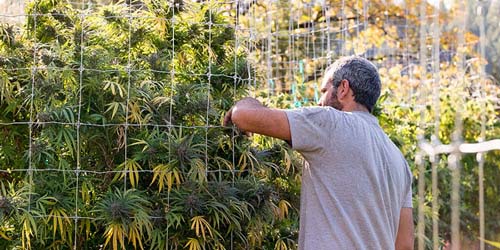
Enjoy gardening and DIY! Trellising is the use of a vertical mesh or trellis screen to increase yield and support huge weed plants. Ideal for outdoor weed growing, because in the garden a weed plant not only gets bigger, but also has more to endure. With a trellis they get more light and the plants can take a beating.
What is a Trellis?
To simplify: a trellis is a mesh panel or fence through which you can weave climbing plants for support. They come in chicken wire, but you can also buy a ready-made wooden trellis screen. Weed trellising is the verb that goes with braiding a trellis. Especially in America, where large legal weed farms are sprouting up like mushrooms, trellises are common. The main purpose of weed trellising is not so much to support the weed plant, but to increase the surface area. This way, more parts of the plant receive light. More light leads to bigger weed plants and a higher yield.
Jorge Cervantes, one of the modern weed pioneers, also uses trellising to grow huge weed plants.
Trellis for weed plant?
Of course, a weed plant is not a climbing plant. But every weed plant loves support. Certainly when they end up with rock-hard buds - because that is what it is all about, of course. With weed plants, the trellis is used in a slightly different way than with ivy. Instead of braiding every branch through it, it is better to see the use of such a mesh panel as vertical scrogging. By forcing the sprouts back into the trellis, you create new growth points and increase the surface area.
ScrOG
In our extensive blog on scrogging you can read that scrogging is a very accessible way to increase yield. This is because a scrog net allows the weed plant to grow more in width. Such a horizontally placed net or screen reduces height considerably, allowing the plant to grow nice and wide with lots of points where buds can develop. This is why scrogging works so well in indoor growing. In a growing space with limited height you can easily increase the yield. You can perhaps imagine that a vertically placed trellis screen makes the weed plant grow more in height. If before this article you have never heard of trellising but you have heard of scrogging, then we can say it is scrogging on its side.
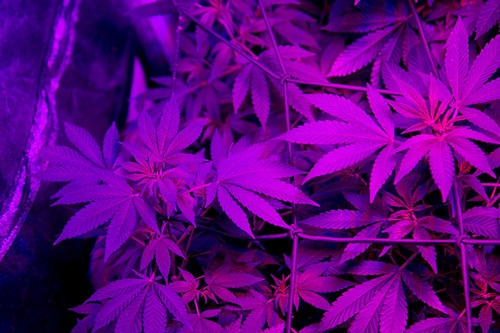
With scrogging, you place a trellis or mesh panel at the top of your weed plant.
Advantages of a Trellis
Making a trellis has several advantages:
- It provides support to heavy weed plants and buds, making them more weather resistant.
- Higher yields due to more light on more leaves.
- Increased airflow means more CO2 available to the leaves and more fresh air, reducing the risk of mould.
- Your plant grows more in height than in width.
Buying a Mesh Panel or Making your own Trellis Screen?
A somewhat handy man can make such a mesh panel himself from material that you might have lying around in the shed. But at the better DIY stores or garden centers, you will find a whole department with these kinds of screens. Go for a mesh panel with large meshes. Square chicken wire with a mesh size of one centimeter is far too small. Take a good look at all the photos in this article to get an idea of what mesh size works.
Furthermore, you need to secure the trellis screen. A flexible trellis can be folded into a cylinder quite easily. Please use gardening gloves for this. The metal material can be very sharp and you can be injured if it contains metal splinters. The diameter of the trellis should preferably be variable. So take a longer piece of mesh panel than you can use to make the first cylinder. More about this under the section “Growing weed with a Trellis in Practice”.
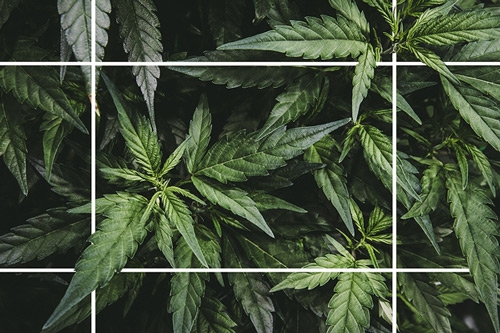
You can also use a stiff material for a trellis screen. A fence of steel or wood is also fine, but keep in mind that bulky structures also block light. This is exactly the opposite of what you want to achieve! We therefore recommend using thin, flexible mesh panels with a mesh size of between 5 and 10 centimeters.
Mesh panel specs for weed trellising
- Preferably a flexible mesh panel made of metal (for example coated with green plastic).
- Take a mesh size of 5-10 centimeters. Square, hexagonal, rectangular: it doesn't matter.
- Choose a mesh panel about four meters wide.
- For small autoflowers it is better to scrog than to make a trellis.
- For large autoflowers and indica plants, take a length of 1.5 meters.
- For the largest weed plants, such as pure sativas, it is best to use a length of 2-3 meters.
- While you're in the shop, buy a whole bunch of tie-wraps to secure the trellis.
Growing weed with a Trellis in Practice
Weed plant in the scaffold! But when can you actually start trellising? As with scrogging, it is best to start early in the growing stage with a trellis. Young plants are always more flexible. At the same time, such a young plant is vulnerable and if you look from above, the diameter is also limited. For this reason, use a trellis that is adjustable.
As soon as your weed plant has passed the seedling phase and is in a pot or full ground, you can get started. The seedling phase passes into the growing phase when the recognizable, hand-shaped weed leaf is actually attached to the plant.
Estimate or measure the diameter of the weed plant. Fold a flexible mesh panel into a cylinder shape that is just slightly larger than the diameter of the weed plant. However, use double or more than you need to make that cylinder. One meter of mesh panel is too little. Think two, three or four meters. A trellis with a circumference of four meters is realistic if you are growing a kush or pure indica, since these plants often grow more in width.
Are you growing a haze or pure sativa and does the plant end up higher than the trellis? Then you can also place several folded cylinders on top of each other and secure them with tie-wraps.
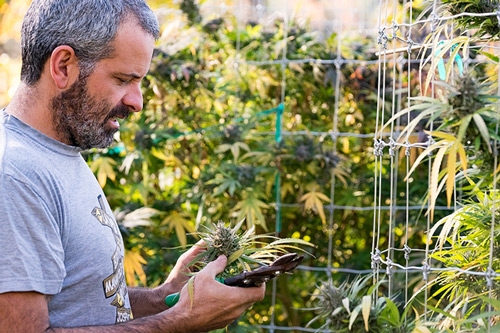
Setting and securing
Just put the trellis on the ground. That gives the best support. You can use the tie-wraps to secure the mesh to the fence or to a couple of large poles. This extra support is great when there is a storm. It is difficult to move your weed plant with a trellis. On the other hand, your plant can withstand much more now that it is in the scaffolding. Whatever you attach the trellis to, make sure that the tie-wraps that hold the trellis in place are always easy to remove.
Vertical Scrogging
In the blog about scrogging you can read that you push the sprouts back under the scrog net. This way you spread the branches so they can receive more light, but also create new growth points. You can do this with a vertical trellis too, but always make sure you give the weed plant as much space and light as possible. You will therefore have to bend some new branches downwards, others to the side and some branches have the most space upwards.
Give your weed plant a week's rest after bending. Then, if necessary, you can carefully loosen the tie-wraps and make the trellis a little bigger. Until the branches touch the mesh panel again, then repeat the steps above. As you can see, it is important to be able to adjust the trellis. Is this not possible because the plant has grown right through it? Then you can simply make a second trellis with a larger diameter. This too is commonly done.
Disadvantages of a trellis
Apart from the fact that making and maintaining a trellis is a lot of work, there is no real disadvantage. Well, if you have to think of a disadvantage: trellising makes for an enormous weed plant in sunny gardens! The plant can grow in all directions with no worries, turning your weed plant into a showy weed tree.
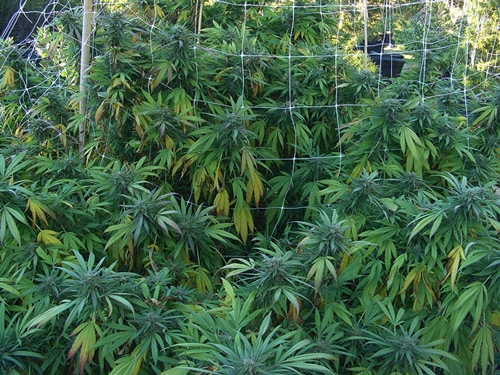
In the garden, such a huge weed plant can not only attract a lot of attention visually, but can also spread quite a scent. The plant is high, has many buds and is airy. As a result, a fragrant weed plant can easily carry its scent to its neighbours and beyond. This is perhaps why weed trellising is so popular in Canada and America. After all, in Canada, but also in South Africa and many American states, it is legal to grow weed. In Europe, however, you have to be careful with large weed plants. In most countries, growing weed is not allowed.